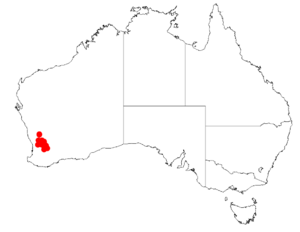Acacia campylophylla facts for kids
Quick facts for kids Acacia campylophylla |
|
|---|---|
| Scientific classification | |
| Genus: |
Acacia
|
| Species: |
campylophylla
|
 |
|
| Occurrence data from AVH | |
Acacia campylophylla is a type of shrub, which is a small, woody plant. It belongs to the Acacia genus, a large group of plants often called wattles in Australia. This particular shrub is special because it is endemic, meaning it only grows naturally in a specific area of southwestern Australia.
What Does It Look Like?
This shrub is usually small. It grows between 0.1 and 0.6 meters (about 4 inches to 2 feet) tall. It has stiff, spreading branches. These branches have ribs and are smooth, meaning they don't have hairs. The tips of the branches might look like they have a fine white powder on them.
The shrub has small, spiny parts called stipules. These are about 0.5 to 1.5 millimeters long. Like many Acacia species, it doesn't have true leaves. Instead, it has phyllodes. These are flattened leaf-like stems that do the job of leaves.
The phyllodes are continuous along the branches. They are strongly curved and have a sharp point. They are grey-green in color. Each phyllode is about 10 to 20 millimeters long and 1 to 1.5 millimeters wide. They have eight clear veins or nerves. This plant blooms with yellow flowers. This usually happens between July and August.
How Was It Named?
A botanist named George Bentham first officially described this plant in 1855. A botanist is a scientist who studies plants. He wrote about it in a scientific journal called Linnaea.
Later, in 2003, another botanist named Leslie Pedley reclassified it. He gave it the name Racosperma campylophyllum. However, in 2006, it was moved back to the Acacia genus. This shows how scientists sometimes change plant names as they learn more.
Where Does It Grow?
Acacia campylophylla is native to the Wheatbelt region of Western Australia. It often grows in gravelly soils that contain laterite. Laterite is a type of soil or rock that is rich in iron and aluminum.
You can find this shrub scattered in different places. It grows from areas like Bolgart and Wyalkatchem in the north. It extends south to places around Corrigin. It usually grows near laterite outcrops. These are places where the laterite rock is visible on the surface. It is part of woodland or heath communities in these areas.

